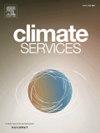埃塞俄比亚南部Sidama地区小农的气候信息服务及其决定因素
IF 4.5
3区 环境科学与生态学
Q2 ENVIRONMENTAL SCIENCES
引用次数: 0
摘要
气候信息服务对农业部门至关重要,使农民能够有效地适应气候引起的挑战并做出明智的决策。本研究探讨了埃塞俄比亚西达马地区小农独联体的现状及其利用情况。通过入户调查、焦点小组讨论、关键信息提供者访谈和实地观察收集数据。采用多阶段抽样技术,有目的地从三个不同的农业生态区中选择了三个工作区(区)。采用系统随机抽样法抽取384户。数据分析采用描述性分析、定性分析、卡方检验和二元logistic回归模型。结果表明,农户对信息系统的了解程度和获取途径处于中等水平,50.8%的农户获得了信息系统,其中只有33.9%的农户积极利用信息系统。信息的主要来源是农业推广人员、广播、电视、移动电话、同行农民和村领导。在低地(39.6%)、中部(36.9%)和高地,只有18.9%的样本家庭利用了这些服务。相对而言,在水分胁迫显著的低地,农民对利用CIS更感兴趣。研究结果还表明,农户的受教育程度、农场规模、信贷可获得性、推广服务可获得性、社会保障服务缺位、收入水平、市场准入和对所提供信息的信任程度是阻碍农业信息系统利用的最突出因素。为了提高生产力,包括地方和区域政府以及农业推广服务在内的利益相关者应与气象服务提供商合作,重点关注改善CIS的可用性、可及性、可靠性和利用率。本文章由计算机程序翻译,如有差异,请以英文原文为准。

Climate information services and its determinants among smallholder farmers in Sidama Region, southern Ethiopia
Climate information services (CIS) are essential for the agricultural sector, empowering farmers to effectively adapt to climate-induced challenges and make informed decisions. This study explored the status of CIS and utilization among smallholder farmers in Sidama region, Ethiopia. Data was collected through household surveys, focus group discussions, key informant interviews, and field observation. Multi-stage sampling techniques were applied and purposefully selected three woredas (districts), from three different agroecological zones. 384 households were selected using a systematic random sampling. Data analysis was conducted using descriptive, qualitative analysis, chi-square tests, and a binary logistic regression model. The results indicated a moderate status of know-how and access to CIS with 50.8% of farmers having access to the CIS, of which only 33.9% actively utilized the information. The primary sources for CIS are agricultural extension officers, radio, television, mobile phones, peer farmers, and village leaders. In the Low lands (39.6%), midland (36.9%), and highland only 18.9% of the sample households utilized the services. The low landers where moisture stress is significant, farmers are more interested in utilizing CIS comparatively. The result also proves that the most prominent factors hindering the utilization of CIS are farmers’ education level, farm size, availability of credit, access to extension services, and absence of social protection services, income level, market access, and trust in the provided information. To enhance productivity, stakeholders including local and regional governments and agricultural extension services in collaboration with meteorological service providers should focus on improving the availability, accessibility, reliability, and utilization of CIS.
求助全文
通过发布文献求助,成功后即可免费获取论文全文。
去求助
来源期刊

Climate Services
Multiple-
CiteScore
5.30
自引率
15.60%
发文量
62
期刊介绍:
The journal Climate Services publishes research with a focus on science-based and user-specific climate information underpinning climate services, ultimately to assist society to adapt to climate change. Climate Services brings science and practice closer together. The journal addresses both researchers in the field of climate service research, and stakeholders and practitioners interested in or already applying climate services. It serves as a means of communication, dialogue and exchange between researchers and stakeholders. Climate services pioneers novel research areas that directly refer to how climate information can be applied in methodologies and tools for adaptation to climate change. It publishes best practice examples, case studies as well as theories, methods and data analysis with a clear connection to climate services. The focus of the published work is often multi-disciplinary, case-specific, tailored to specific sectors and strongly application-oriented. To offer a suitable outlet for such studies, Climate Services journal introduced a new section in the research article type. The research article contains a classical scientific part as well as a section with easily understandable practical implications for policy makers and practitioners. The journal''s focus is on the use and usability of climate information for adaptation purposes underpinning climate services.
 求助内容:
求助内容: 应助结果提醒方式:
应助结果提醒方式:


